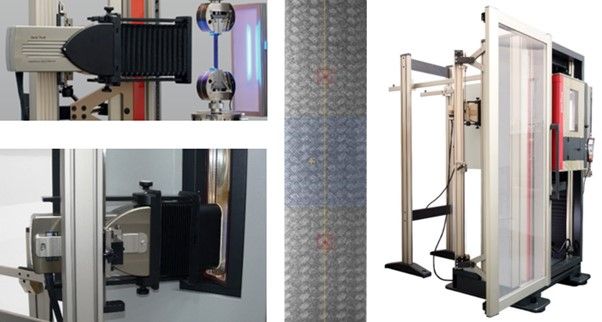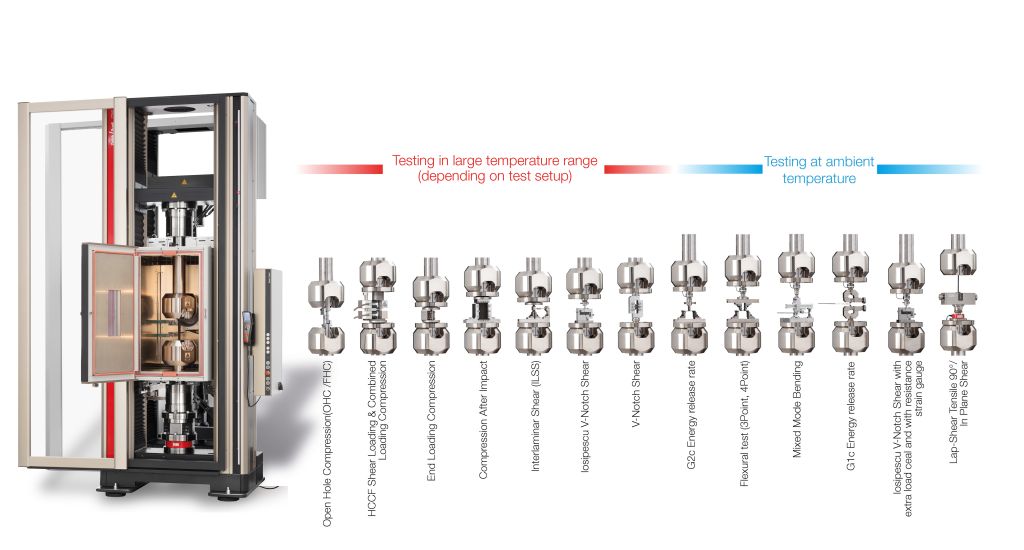Measuring up to aerospace testing

When it comes to testing the types of fibre-reinforced polymer matrix composites used in the aerospace sector, Zwick says its static and dynamic test equipment measures up.
Since the mechanical response of fibre-reinforced polymer matrix composites is strongly affected by temperature, composites used in aerospace structures need to be tested at low and elevated temperatures. In addition, moisture uptake in a composite material over the lifetime of a composite structure is known to have a detrimental effect on the mechanical behaviour and material properties.
Therefore, standardised static testing needs to be done to obtain the mechanical response of the composite lamina and for multidirectional laminates at different temperature and moisture levels: -54°C cold temperature dry (CTD), +93°C elevated temperature dry (ETD), +93°C elevated temperature wet (ETW) and +121°C elevated temperature wet (ETW). This covers the temperature range from low temperatures during flight at cruising altitudes to elevated temperatures on the ground in hot climates. For the wet testing condition, the test coupons are conditioned for several weeks until the desired moisture state in the material is reached. These moisture conditioned samples are then tested at the desired temperature using a static testing machine incorporating a temperature chamber.

Typical static tests done on the lamina level are: unnotched tension and compression, in-plane shear, or short beam shear strength. Typical static tests on the laminate level are: unnotched tension and compression, open hole tension and compression, filled hole tension and compression, short beam shear strength, pin bearing, curved beam strength or compression after impact. In both cases, this includes only the most common methods, while several other static test methods are carried out as well.
While the vast majority of coupon testing for composite materials is done under static loading conditions, the fatigue response of structural laminates is also evaluated using for example unnotched tension, open hole and filled hole tension and compression, short beam shear strength or compression after impact test methods.
Depending on the expected maximum load, the static tests are done on either a 100kN or 250kN testing machine with suitable grips for the tension type specimens while making sure that other test fixtures can be mounted as well.
For Nadcap accredited testing laboratories, it is crucial to verify correct alignment or the specimen grips. In this case the testing machine should be equipped with a mechanical alignment unit to be able to correct any misalignment in the load chain. The alignment device is mounted between the load cell and the hydraulic unit of the lower hydraulic grips.
Temperature extremes
To be able to perform tests at low and high temperatures, the testing machine can be equipped with a temperature chamber covering a temperature range from -80°C to +250°C or -80° to +360°C. A 360°C temperature chamber allows testing well beyond the above mentioned temperature range, which today is required for the development of new composite materials systems that will be exposed to higher temperatures, e.g., near engine exhausts.
A major challenge at low and elevated temperature testing is accurate and high-resolution strain measurement, which needs to be done directly on the tensile specimen, using contact or non-contact technologies. While the use of strain gauges, bonded to the specimen for axial or transverse strain measurement, has been an established method for decades and is still the standard method for unnotched compression testing, it is also costly and time-consuming. With the increasing use of thermoplastic composites in aerospace composite structures, it can be challenging for some thermoplastic matrix systems to bond a strain gauge to the composite specimen. Contacting clip-on extensometers are an economic alternative, but they can be damaged if used until ultimate failure, particularly for tensile specimens with explosive failure modes.

Automatic sensor-arm extensometers can be employed until ultimate failure and can be used for non-ambient temperature testing in a temperature chamber as well.
Non-contact optical strain measurement using a video extensometer allows accurate and high-resolution axial and transverse strain measurement over the entire temperature range from -80°C to +360°C and is thus the most versatile strain measurement system for composites over a wide temperature range. The ZwickRoell videoXtens biax 2-150 HP was specifically developed for the testing needs of composites. For many composite material systems and particularly for carbon fibre-reinforced plastics, no further specimen preparation for strain measurement is needed since it uses the natural surface pattern of the specimen to set the gauge marks. For flexure testing, a mechanical plunger is available, which extends the use of the videoXtens to flexural testing as well.
Innovation beats vibration
Considering fatigue of materials used in aircraft structures is important due to intense vibrations during take-off and landing, engine vibrations or turbulent flight conditions. Wing structures and the materials used in it accumulate a large number of load cycles over the lifetime of an aircraft, from when the aircraft is on the ground and the wing is pulled down by gravitational forces, to when the wings bend upwards from aerodynamic forces during flight. While the importance of fatigue testing increases when moving up in the testing pyramid from the coupon test level with many standardised test methods to structural elements, sub-structures all the way to the full structural level, fatigue testing of materials on the coupon level is important to obtain data for fatigue tolerant design or lifetime predictions.
For dynamic materials testing, servo-hydraulic testing machines are common, since they are most versatile when it comes to load range and testing frequencies. If needed they can also be used for static testing, whereas they do not offer the simplicity of setting up very different types of static test methods as is possible for example with an electromechanical testing machine (see above static modular testing machine).
For the load range of 100kN, typically used for fatigue testing of metals and composite materials on the coupon level, ZwickRoell has developed a compact dynamic testing machine with integrated hydraulic power pack. The compact design makes the machine independent from a centralised hydraulic supply, has a lower footprint compared to when a separate hydraulic power pack is placed next to the machine and operates at a very acceptable noise level of <58dB. An integrated cooling system prevents heating of the laboratory and thus a standard laboratory climate is unaffected.
The mechanical testing of composite materials is a complex topic, involving a range of test configurations, a wide selection of recognised testing standards and frequently the need to test in a variety of different environments. The availability of well-aligned test machines and gripping arrangements, advanced technology extensometers, interchangeable test fixtures and intuitive testing software, facilitates the mechanical testing requirements demanded by R&D, and routine quality assurance.









